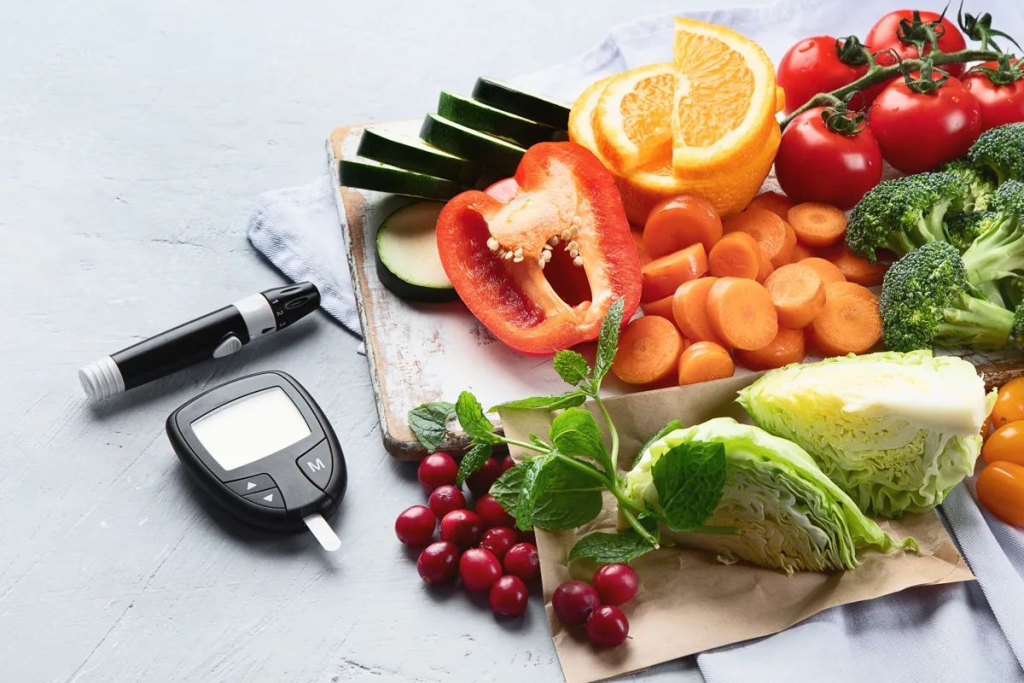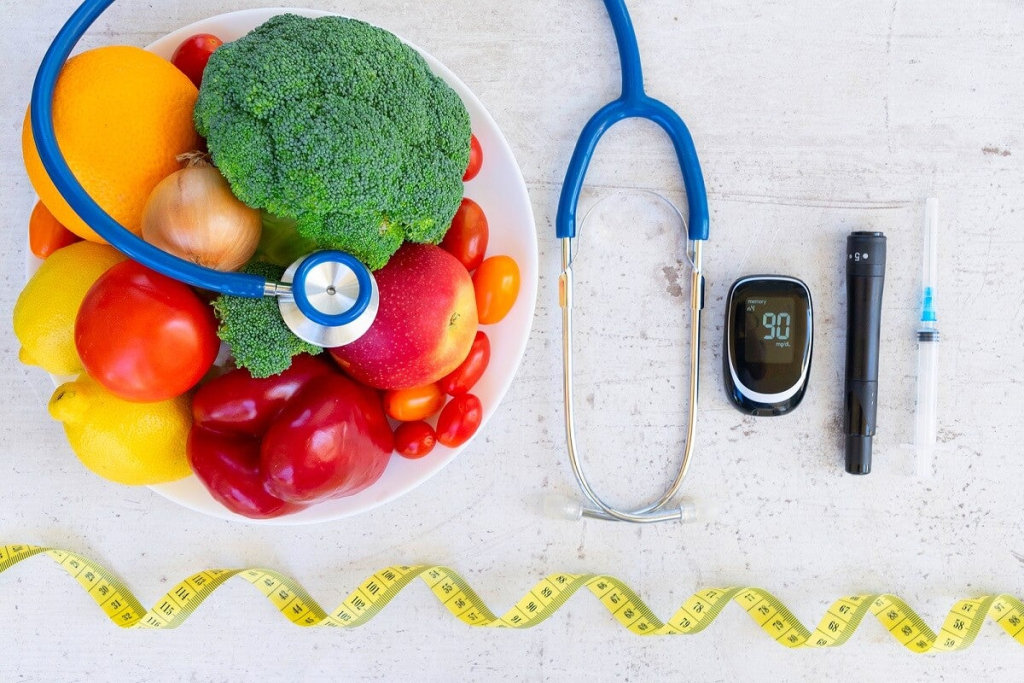Managing diabetes in kids means focusing on diet and nutrition. They should stay away from foods that can make their blood sugar go up. This also helps prevent heart disease.

Foods with lots of added sugars, like sugary drinks and sweets, are bad news. We must watch out for carbohydrates too, as they can also raise blood sugar. To help, it’s key to know which foods to cut down on or avoid. For a balanced meal plan, understanding these foods is essential. A smart diet for diabetics helps children stay healthy. Learn the foods kids with diabetes should always avoid for better control.
Managing a child’s diet is key when they have diabetes. It affects their health and happiness. Knowing the difference between Type 1 and Type 2 diabetes is important. It helps us understand how food choices control blood sugar levels.
Type 1 diabetes happens when the body attacks its own insulin-making cells. This means no insulin is made. Type 2 diabetes is when the body doesn’t use insulin well and doesn’t make enough. Knowing these facts helps us plan the right diet.
For Type 1 diabetes, we balance carbs with insulin. For Type 2 diabetes, we focus on improving how well the body uses insulin through diet.
Foods with carbs, like sugars and bread, affect blood sugar. Choosing the right foods is key for keeping blood sugar in check.
The CDC says one in five kids in the U.S. drinks sugary drinks every day. Cutting down on these drinks is important for managing blood sugar.

Poor diet choices can lead to serious health problems later on. These include heart disease and nerve damage. A good diet helps avoid these issues.
Eating a balanced diet with good foods for diabetics helps manage diabetes. Foods high in fiber, lean proteins, and healthy fats are best.
Sugary drinks are a big worry for kids with diabetes because they have a lot of sugar. These drinks can quickly raise blood sugar levels, making them very bad.

Drinking sugary beverages can cause many health problems for kids with diabetes. These drinks don’t have fibre, so the sugar goes straight into the blood. This makes blood sugar levels go up fast.
Sodas and soft drinks are big sources of added sugars in a kid’s diet. They don’t have any good nutrients and can quickly raise blood sugar levels.
Fruit juices seem like a better choice than sodas, but they’re not. They have a lot of natural sugars and don’t have the fiber of whole fruits. This makes them a problem for kids with diabetes.
Sports and energy drinks are bad for kids with diabetes, too. They have a lot of added sugars and are made to give a quick energy boost. This can be very harmful.
The Centers for Disease Control and Prevention (CDC) says 1 in 5 kids drink sugary drinks every day. This shows how common it is for kids to drink sugary drinks. Parents and caregivers need to watch what drinks they give to kids with diabetes.
To help manage diabetes, it’s important to avoid sugary drinks. Kids with diabetes should drink water, unsweetened tea, or low-fat milk instead. Making smart choices about drinks can help kids with diabetes keep their blood sugar in check and stay healthy.
Knowing which foods have a high glycemic index is key for kids with diabetes. These foods are quickly absorbed, causing blood sugar to rise fast. A diet full of refined grains and sugary foods can make blood sugar hard to control, says a diabetes expert. It’s important for parents and caregivers to know which foods to limit in a child’s diet.
White bread, bagels, and other refined flour products are high glycemic index foods. They are quickly turned into glucose, leading to a quick spike in blood sugar. Choosing whole-grain alternatives can help avoid this spike.
Many breakfast cereals and instant oatmeals are high in added sugars and have a high glycemic index. They can cause a big jump in blood glucose levels. Choosing low-sugar, high-fiber cereals and making oatmeal with less sugar is a better choice.
White rice and regular pasta are also high glycemic index foods. They have refined carbohydrates that can quickly raise blood sugar. Replacing them with brown rice and whole-grain pasta can help keep blood sugar stable.
Candy, cookies, and other sweet treats are high in sugar and have a high glycemic index. They are bad for kids with diabetes. It’s important to limit these foods and find healthier dessert options to keep blood sugar in check.
By knowing about these high glycemic index foods and making smart food choices, parents can help their kids with diabetes manage their condition better. Foods like whole grains, fruits, and vegetables are good because they have fiber, vitamins, and other nutrients that help keep blood sugar stable.
Children with diabetes must watch out for processed snacks and packaged foods. These foods have added sugars, sodium, and preservatives. They can raise blood sugar and harm health in the long run.
Salty snacks like chips and crackers have too much sodium and unhealthy fats. They also have artificial additives. Eating these snacks often can raise blood pressure and heart risks. It’s essential to limit or avoid these snacks to keep health and blood sugar stable.
Many granola bars seem healthy, but have lots of added sugars. Always read the labels carefully to see how much sugar and carbs they have. Choose granola bars with less sugar and more fiber.
Processed meats like hot dogs and sausages have a lot of sodium and preservatives. These can be bad for children with diabetes. Choosing fresh, unprocessed meats is a better choice for protein.
Store-bought baked goods and desserts have lots of added sugars, unhealthy fats, and refined carbs. They can make blood sugar levels go up a lot. Preparing homemade baked goods with healthier ingredients is a better option for managing diabetes.
Reading food labels is key for managing diabetes. It helps know the carbs, fiber, and added sugars in foods. By checking ingredients and nutritional content, parents can choose better snacks for their kids.
Managing diabetes in children means avoiding processed snacks and packaged foods. Limiting these foods is a critical step for their health and stability.
“The key to managing diabetes is through a combination of healthy eating, regular physical activity, and monitoring blood glucose levels.”
” American Diabetes Association
Managing diabetes means knowing about dietary fats, like saturated and trans fats. These fats are not as good as others, like polyunsaturated and monounsaturated fats. It’s key to choose the right fats for a balanced diet.
Fried foods are bad for kids with diabetes. They have too many calories and not enough good stuff. Plus, they’re full of saturated and trans fats. Eating them often can make you gain weight and hurt your heart.
Some fried foods to cut down on are:
Fast food is often loaded with bad fats. These fats can harm a child’s health, leading to obesity and heart disease. It’s important to make smart choices.
Here’s how to eat better:
Full-fat dairy and fatty meats have a lot of saturated fats. They can be okay in small amounts, but picking lower-fat options is better. This helps keep saturated fat intake down.
Healthier choices include:
Trans fats in packaged foods are very bad. They increase bad cholesterol and lower good cholesterol, raising heart disease risk.
To avoid trans fats, do this:
By watching what we eat, we can help kids with diabetes stay healthy. This reduces their risk of heart problems.
For kids with diabetes, eating right is very important. A balanced diet helps keep blood sugar levels healthy. It also supports growth and gives energy all day.
We suggest a diet full of nutrient-dense foods. Key foods are fiber-rich, lean proteins, healthy fats, and low-glycemic carbs. These foods help keep blood sugar stable and support health.
Fiber-rich foods are key in managing blood sugar. They slow down carb digestion, preventing blood sugar spikes. Good examples include:
Adding these foods to meals helps kids with diabetes keep their blood sugar stable.
Lean proteins are vital for kids’ growth and health. They also help control blood sugar by slowing glucose absorption. Good lean protein sources are:
A meal with carbs, protein, and healthy fats can slow digestion. This helps keep blood sugar levels healthy.
Healthy fats are important for brain function, hormone production, and vitamin absorption. They also keep kids full, reducing overeating. Good sources include:
Healthy fats in the diet support health and help manage diabetes.
Low-glycemic carbs are digested slowly, causing a gradual blood sugar increase. This prevents spikes and crashes, giving sustained energy. Good examples are:
Choosing low-glycemic carbs helps kids with diabetes stay energized all day.
Diets high in fiber and low in added sugar help manage blood sugar and support health. By eating fiber-rich foods, lean proteins, healthy fats, and low-glycemic carbs, kids with diabetes can manage their condition well. They can enjoy a healthy, active life.
Every child with diabetes is unique, needing different nutrition. At Liv Hospital, we focus on tailored diets for young diabetic patients. This ensures their nutritional needs are met.
Liv Hospital creates customized meal plans for kids with diabetes. These plans consider age, size, activity level, and food likes. A registered dietitian works with families to make a plan that works well.
Our team knows every child is different. We make plans that fit their needs. This helps manage blood sugar and supports growth.
Working with healthcare providers is key to making meal plans for kids with diabetes. Together, we create plans that meet their specific needs and health goals.
Healthcare providers are vital in monitoring the child’s health and adjusting the meal plan. This teamwork ensures the child gets the care they need for nutrition and health.
Children with diabetes have different activity levels and growth needs. A diet tailored to these can help control blood sugar.
For example, active kids might need more carbs for energy. Less active kids might need fewer carbs. Tailoring the diet helps achieve better glucose control and health.
Monitoring blood glucose is key in managing diabetes in kids. By tracking how different foods affect blood sugar, we can adjust their diet for better control.
This means working with the child and family to find better food choices. By making informed choices, we help keep blood sugar in check and reduce risks.
Helping kids with diabetes make smart food choices is key. They can control their blood sugar better by knowing what to eat and what to avoid. At Liv Hospital, we focus on top-notch healthcare and support to lead in diabetes care.
Teaching kids to balance carbs, protein, and fats is important. We stress the value of fiber, lean proteins, healthy fats, and low-carb foods. This way, they can live active, healthy lives.
We work with kids and their doctors to create diet plans that fit them. This helps them manage their diabetes better. It also improves their overall health and happiness.
A child with diabetes should eat foods high in fiber, lean proteins, and healthy fats. They should also choose low-glycemic carbs. These foods help keep blood sugar stable, support growth, and give lasting energy.
Children with diabetes should avoid foods that raise blood sugar too fast. This includes sugary drinks, foods with a high glycemic index, and processed snacks. They should also limit foods high in saturated and trans fats.
Type 1 diabetes occurs when the body attacks and destroys insulin-making cells. This means no insulin is made. Type 2 diabetes occurs when the body doesn’t use insulin well and doesn’t make enough.
Sugary drinks, like sodas and fruit juices, have lots of added sugars. They can quickly raise blood sugar levels.
Instead of sugary drinks, try water, unsweetened tea, and low-fat milk. These choices help keep blood sugar stable and reduce added sugar intake.
High glycemic index foods include white bread, sugary cereals, and sweets. They can quickly raise blood sugar.
When reading labels, look for added sugars, sodium, and preservatives. Choose foods with fewer ingredients. Opt for whole, unprocessed foods whenever you can.
Add healthy fats like nuts, seeds, avocados, and olive oil to meals and snacks. Use avocado in sandwiches or as a dip.
Personalized nutrition helps tailor a child’s diet to their needs. It considers their activity level, growth, and how they respond to food.
Creating a meal plan involves talking with your healthcare provider. Discuss your child’s needs, activity level, and blood sugar goals. Then, develop a plan that fits these factors.
Subscribe to our e-newsletter to stay informed about the latest innovations in the world of health and exclusive offers!
WhatsApp us